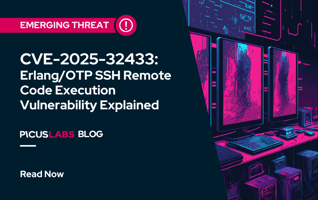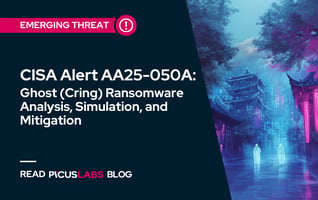Agentless Security Validation - How Picus Emerging Threat Simulator Works?
Adversaries continue to come up with new and more sophisticated ways to evolve their cyber-attack tools and techniques. The latest and evolving cyber threats are called emerging threats, and safeguarding organizations against them is crucial to maintain the security and integrity of their operations. To ensure their infrastructure is safe against emerging threats, security teams often utilize the security validation approach and proactively validate their security posture before adversaries can exploit any weakness.
In this blog post, we explained the inner workings of Picus Emerging Threat Simulator and how Picus offers risk-free and frictionless security validation against emerging threats.
What are Emerging Threats?
Emerging threats are dynamic and multifaceted cyber threats that are driven by continuous adoption of new vulnerabilities, malware, or adversary techniques. Due to their novelty, emerging threats are harder to defend against and their impact is more likely to be widespread, even global. These threats can disrupt operations, cause significant financial losses, damage reputations, and lead to legal and regulatory repercussions.
The landscape of emerging threats is vast and varied; however, emerging threats can be categorized as ransomware, APTs, supply chain attacks, and zero-day and critical vulnerabilities.
-
Ransomware threats have become much more prominent in recent years. Adversaries use ransomware payloads to encrypt victims’ sensitive data and demand ransom for the decryption keys. Ransomware attacks have become increasingly sophisticated, targeting not only individual users but also large organizations, healthcare institutions, and critical infrastructure. The growing prevalence of Ransomware-as-a-Service (RaaS) groups has lowered the barrier to entry for cybercriminals, making these attacks more frequent and widespread.
-
Advanced Persistent Threats (APTs) are prolonged and targeted cyber threats where an intruder gains access to a network and remains undetected for an extended period. The goal of APTs is often to steal sensitive data, such as intellectual property or government secrets, rather than cause immediate damage. These attacks are typically carried out by highly skilled threat actors, including nation-states and organized crime groups, using sophisticated techniques to evade detection and maintain access. Due to their tremendous impact and capabilities, APTs are considered as emerging threats.
-
Supply chain attacks are increasingly prevalent, targeting the interconnected networks of suppliers, vendors, and service providers that organizations rely on. By compromising a less secure element within the supply chain, attackers can gain access to more secure targets, bypassing traditional security measures. These attacks exploit the trust and access relationships within the supply chain, making them particularly insidious and challenging to detect.
-
Zero-day vulnerabilities refer to previously unknown flaws or weaknesses in software or hardware that have not yet been patched or mitigated by the developer. The term "zero-day" highlights the urgency and novelty of these vulnerabilities, indicating that developers and security teams have had zero days to address and fix the issue before it is exploited. Their unknown nature, potential for significant impact, association with sophisticated attackers, and presence in underground markets make zero-day vulnerabilities formidable emerging threats.
-
Critical vulnerabilities are severe weaknesses in software, hardware, or network systems that, if exploited, could lead to significant harm, such as unauthorized access, data breaches, system disruptions, or complete system takeovers. The critical nature of these vulnerabilities stems from the extensive damage they can cause and the high likelihood of their exploitation by malicious actors.
Security Validation Against Emerging Threats with Picus
Security validation is an essential security practice that involves simulating attacks and probing for vulnerabilities in systems, networks, and applications to ensure that the defenses in place are effective and up to date. By proactively identifying weaknesses, security validation allows organizations to address potential threats before they can be exploited by malicious actors.
The security validation approach achieves its objectives by providing a realistic assessment of an organization’s security posture. Traditional security measures, such as firewalls and antivirus software, often rely on known threat signatures and predefined rules, which may not be effective against new or sophisticated attacks. Security validation, however, uses a variety of adversary tactics, techniques, and procedures (TTPs) used by real-world attackers to mimic actual cyber-attacks. This approach helps security teams simulate what would have happened if a real attacker had exploited existing security gaps and provides a more comprehensive understanding of the organization's resilience against advanced threats.
Since emerging threats use new and novel adversary techniques, security teams might not have the full picture of the threat and extract the TTPs involved. At this point, Picus becomes a great ally on the security teams’ side. Whenever an emerging threat is discovered, Picus Labs swiftly adds a new threat simulation to Picus Threat Library, saving security teams from the hassle of searching threat intelligence sources and extracting adversary TTPs related to the emerging threat. Additionally, Picus Labs adds actionable mitigation suggestions to Picus Mitigation Library to remediate the simulated threat. Now, security teams can validate their security posture against emerging threats effortlessly and apply mitigations if necessary.
How Does Picus Security Validation Platform Work?
As the pioneer of the Breach and Attack Simulation technology, Picus helps organizations continuously validate the effectiveness of their security controls so that they can obtain a holistic view of their security posture and take swift action to strengthen it. Let’s take a more detailed look into how the Picus Platform performs security validation.
Figure 1: Overview of Picus Platform Attack Simulation
Picus Platform is designed to provide continuous and automated testing of an organization’s security posture by simulating real-world attacks. The architecture of Picus involves several key components and processes that work together to emulate potential breaches and attack scenarios, assess the effectiveness of defenses, and provide actionable insights.
-
Simulation Agents: Picus utilizes agents that are strategically placed across various segments of the IT environment, including endpoints, servers, and network devices. The agents are responsible for executing simulated attack scenarios without causing actual harm to the systems. They mimic the behavior of adversaries by launching benign payloads that simulate a wide range of attack techniques, such as vulnerability exploitation, malware injection, lateral movement, and data exfiltration.
-
Picus Dashboard: Picus dashboard is a cloud-based console that serves as the control center for the Picus Platform. It orchestrates the simulations, aggregates data, and provides a user-friendly interface for security teams. From the dashboard, security teams can configure and initiate various attack scenarios, schedule regular simulations, and monitor the outcomes in real time. The dashboard also allows for the customization of attack parameters to reflect specific threats relevant to the organization's environment and industry.
During a simulation, the agents execute predefined attack sequences, starting with initial access attempts and progressing through various stages of an attack lifecycle. Each stage is meticulously designed to test specific security controls, such as NGFW, WAF, IDS, IPS, EDR, and DLP mechanisms. The agents collect detailed telemetry data on the success or failure of each attack step, which is then sent back to the Picus Platform for analysis.
This is a simplified explanation of how the Picus Platform validates the security posture of an organization’s network. As you can see, agents are an essential part of the design, and security teams need to set them up beforehand for threat simulation. However, we can eliminate this requirement with a simple yet clever trick. How about we use the browser as an agent?
Picus Emerging Threat Simulator
Picus Emerging Threat Simulator is a free and online threat simulator powered by the Picus Platform. It mimics cyber attacks in a controlled and safe manner by utilizing the user’s browser as a simulation agent. This approach is also called agentless because it uses existing infrastructure and eliminates the need to deploy an agent beforehand.
With a few clicks, Picus Emerging Threat Simulator allows security teams to test their defenses against the latest threats. Since it is powered by the Picus Platform, the Picus Emerging Threat Simulator ensures it does not spread cyberattacks or have a negative impact on your environment. Here are several key reasons why you can be confident that Picus Emerging Threat Simulator is safe to use:
-
No Interaction with Production Assets: Picus Emerging Threat Simulator operates without any interaction with assets in your production network. The simulator only mimics cyber attacks in a controlled and safe manner, ensuring that your actual production assets remain untouched. After the simulation is completed, the whole process is reversed, and the production environment is left as it is found. This approach ensures that testing does not interfere with actual production systems, preventing any risk of damage or disruption to those systems.
-
Low Network Load: Picus Emerging Threat Simulator generates minimal network load, comparable to a user browsing a news website. This means that the network activity generated by Picus is very low and should not disrupt your normal network operations or cause any performance issues. Picus is designed to be non-intrusive in this regard.
-
Non-Invasive and Non-Destructive Assessment Methodology: Picus Emerging Threat Simulator is designed to simulate attacks without altering or damaging target systems. It does not attempt to exploit vulnerabilities in a way that could lead to data loss, system crashes, or any other negative impacts. This approach rules out the possibility of data corruption, system instability, or inadvertent triggering of real security incidents, thereby safeguarding the integrity of your systems.
See Picus Emerging Threat Simulator in Action
We saved the best for the last. Picus Emerging Threat Simulator does not require any registration, and you can validate your security posture as many times as possible.
Feel free to visit Picus Emerging Threat Simulator and validate whether your controls can block the latest emerging threats for free.








